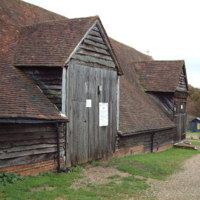Description
Deep in the countryside of Buckinghamshire, in the small Quaker village of Jordans, the ‘Mayflower Barn’ has been claimed since the early 20th century to be made out of timbers from the original ship. James Rendel Harris, a notable if eccentric biblical scholar, made this ‘discovery’ in 1920 after being told of the folklore by a mysterious man at a funeral. It was fortuitous for Harris – given that he was the Chairman of the organisation that was organising the 300th anniversary celebrations, and also a Quaker trying to draw attention to the village – but he carried out extensive (if speculative) research to make his argument. The public – both in Britain and the USA – went wild for the Barn and came from near and wide to visit throughout the mid part of the twentieth century. Politicians and diplomats were interested in the commemorative power of the barn, too: in 1921, the Quakers presented a part of one of the timbers to Samuel Hills (an American Quaker), who placed it in a chest inside the Pacific Highway Association Peace on the boundary of the USA and Canada to commemorate the ‘common ancestry’ and century of Anglo-American peace; and, during the Second World War, wood from the rafters was used to create a ‘Mayflower medal’ for Winston Churchill to give to Franklin D. Roosevelt. By the 1960s a lot of this enthusiasm had died down, and the structure was becoming dilapidated – fortunately, the Pilgrim Trust (after some wrangling) contributed a donation for repairs. The barn was Grade II listed in 1982 – though for its 17th century origins rather than any belief that it was actually the final resting place of the Mayflower – and still stands today.
For more information, see our extended feature on the Mayflower Barn: http://voyagingthroughhistory.exeter.ac.uk/2019/06/28/the-mayflower-barn-mystery-and-history-in-buckinghamshire/





